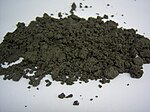Mineral CSA (brand)
Mineral CSA is a finely ground calcium silicate feedstock produced by the U.S.-based company Harsco Minerals, which provides a solution for correcting acidic conditions and managing toxic metals associated with acid mine drainage (AMD). Mineral CSA has been used on operating and abandoned mine sites since 1991.[1] It is a highly refined, repurposed calcium silicate aggregate. Its parent material is a downstream stainless steel furnace slag that undergoes “ageing” processes, fine grind pulverizing, and extensive metal separation (>99.95% of all metals removed) to remove impurities.
Mineral CSA was manufactured by Recmix, established in 1989 in Canonsburg, PA. In 1996, Recmix opened a second manufacturing facility in Sarver, PA.[2] In early 2007, Harsco Corporation acquired the company as part of its Harsco Minerals division (headquartered in Mechanicsburg, PA).[3]
Raising pH[edit]
Calcium silicate neutralizes active acidity by removing free hydrogen ions from the bulk solution, thereby increasing pH.[citation needed] As its silicate anion captures H+ ions (raising the pH), it forms monosilicic acid (H4SiO4), a neutral solute. Monosilicic acid remains in the bulk solution to aid in correcting the adverse effects of acidic conditions.[4]
CaSiO3 + 2H+ + H2O → Ca2+ + H4SiO4 (monosilicic acid)
(Calcium silicate + Acidity + Water → Calcium + Monosilicic acid (neutral solute))
In the bulk solution, the silicate anion of Mineral CSA is very active in neutralizing H+ cations in the soil solution. Its CCE value is 90 – 100% and its relative neutralizing value is 98%.
Mineral CSA’s (calcium silicate) ability to ameliorate the adverse effects of acidic soil allows it to aid in the revegetation of acidic soils.
Precipitating heavy metals[edit]
In the presence of heavy metals, the calcium silicate aggregate reacts to form colloidal complexes with neutral or negative surface charges. These negatively charged colloids create an electrostatic repulsion with each other and precipitate heavy metals, preventing armoring of the material.[4] This provides longer-lasting effectiveness of the material at AMD sites, as opposed to limestone (a popular remediation material)[5] which tends to armor over, rendering it ineffective.[4][6]
Properties[edit]
Typical Analysis[7]
| Calcium | 26-28% |
| Soluble Silicon (compared to wollastonite) | 113-114% |
| pH | 12.4 |
| Calcium Carbonate Equivalent | 90-100% |
| Relative Neutralizing Value [.95x(99-90)/2+99] | 98% |
| Minimum Passing #20 Mesh Screen | 99% |
| Minimum Passing #100 Mesh Screen | 65% |
| Typical Moisture Content | 14-20% |
Dry weight basis:
| Calcium | 26-28% |
| Magnesium | 6-8% |
| Calcium Carbonate Equivalent | 90-100% |
| Minimum Passing #20 Mesh Screen | 99% |
| Minimum Passing #60 Mesh Screen | 90% |
| Minimum Passing #100 Mesh Screen | 75% |
| Typical Moisture Content | 10-18% |
| Relative Neutralizing Value [.95x(99-90)/2+99] | 98% |
Soluble silicon release:
| Material Tested | Range of Soluble Silica as % of Control |
|---|---|
| Mineral CSA | 113-149 |
| Vansil – Control | 100 |
| Titanium Iron Slag | 73-97 |
| Basic Oxygen Furnace Slag | 13-68 |
| Furnace Slag (BOF) | 37-38 |
| Silica Steel Slag | 49-53 |
References[edit]
- ↑ "About Mineral CSA" (PDF). Harsco Minerals. Retrieved 29 March 2011.
- ↑ "Recmix.com About Us". Retrieved 30 March 2011.
- ↑ "EX-21 Subsidiaries of the Registrant". Harsco Corp 10-K for 12/31/07. Retrieved 30 March 2011.
- ↑ 4.0 4.1 4.2 Ziemkiewicz, Paul. "The Use of Steel Slag in Acid Mine Drainage Treatment and Control". Archived from the original on 20 July 2011. Retrieved 25 April 2011.
- ↑ Skousen, Jeff. "Chemicals". Overview of Acid Mine Drainage Treatment with Chemicals. West Virginia University Extension Service. Archived from the original on 24 May 2011. Retrieved 29 March 2011.
- ↑ Hammarstrom, Jane M.; Philip L. Sibrell; Harvey E. Belkin. "Characterization of limestone reacted with acid-mine drainage" (PDF). Applied Geochemistry (18): 1710–1714. Retrieved 30 March 2011.
- ↑ Calcium Silicon-Based Mineral CSA. Harsco Minerals.
External links[edit]
This article "Mineral CSA (brand)" is from Wikipedia. The list of its authors can be seen in its historical. Articles copied from Draft Namespace on Wikipedia could be seen on the Draft Namespace of Wikipedia and not main one.


